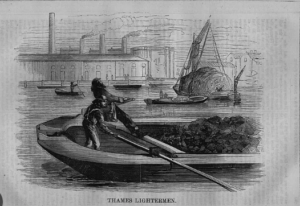b.1868-d.1920
When Edward Dillon Barrett died in Long Grove in 1920 he had spent more than half of his life in mental institutions. He was born in the Gloucestershire village of Woodchester, about two miles from Stroud, in the 2nd quarter of 1868.
Edward’s father, Edward Peter Barrett
Edward Dillon was the first child of Baptist minister Edward Peter Barrett and his wife Emily (née Watts). Edward Peter was born in Limehouse, East London, in the 1st quarter of 1842. He was the son of frame-maker William Henry Barrett and his wife Anne (née Dillon, for whom our subject was named).
Edward’s mother, Emily Watts
The family of Emily Watts has proved more difficult to trace. In the censuses taken after her marriage, Emily’s date and place of birth are given as 1843/4 in Drayton, Berkshire. Indeed, the birth of an Emily Watts was registered in Abingdon (just one mile from Drayton) in the 3rd quarter of 1843. However, no further details are given in the register. According to the General Register Office records, Emily’s mother’s maiden name was Taylor. A George Watts married a Sarah Taylor in Witney, Oxfordshire in the 3rd quarter of 1841. However, it has not been possible to ascertain whether or not these were Emily’s parents.
1851 Census
Interestingly, in the 1851 Census we find seven year-old Emma Watts living in Grange Court, Chigwell, the home of wealthy landowner and former High Sheriff of Essex, William Whitaker Maitland.
Emily appears on the census after Maitland, his wife Anne, seven of their children, a governess, and nine servants. One of these servants is William Taylor, aged 44 of Drayton, Berkshire. William is married to Lucy Taylor, also aged 44, from Nottinghamshire. Although resident in the house, Lucy has no occupation and, crucially, Emily’s relationship to the Taylors is not given.
Research has shown that at the time of the 1841 Census, when both were aged 34, William and Lucy were already living with the Maitlands. It appears they had married quarters separate from the rest of the staff. No offspring are mentioned and, again, no occupation is listed for Lucy.
1861 Census
In the 1861 Census we find William Taylor, now a widower, living at Loughton Hall in Essex, an imposing property which William Maitland had inherited from his father. William is still serving the Maitland family, though is now employed as a coachman.
Seventeen year-old Emily is now listed as William’s niece. From this, we may deduce that she was the daughter of William’s sister though it is not known why he and Lucy were acting as her guardians. A Sarah Watts aged 28 died in Witney in the 1st quarter of 1843. Is it too fanciful to suggest that this was Emily’s mother who died in childbirth and her death caused a delay in registering the child’s birth?
From this distance and without further documentation it is impossible to know for sure but it does appear that Emily was living with her uncle and aunt from early childhood until her marriage to Edward Peter Barrett.
Marriage
By the time of the 1851 Census William Henry Barrett and his family had moved from their home in Chelsea to Alma Cottage on York Hill in Loughton, just a mile from Loughton Hall. In the 1861 Census we find Edward Peter employed, like his father, as a frame maker. He was living at Alma Cottage with his parents and his younger siblings Ann, Amelia, Elizabeth and Thomas. It is reasonable to assume that it was in Loughton that Edward Peter and Emily first met. The couple married in Epping, Essex, in the 2nd quarter of 1867.
A Baptist minister
We do not know when Edward gave up frame-making to become a Baptist minister or if the move to Gloucestershire (where Edward Dillon was born) was connected to his ministry in the church. However, in the 1871 Census, four years after his marriage, we find him and a George Bowsher, both described as Baptist ministers. They were visiting Rebecca Alexander, a woman of independent means, at her home in Grace Villas, Kennington.
At this time, we find Emily living over 100 miles away in Bromsgrove, Worcestershire, with her two year-old son, our subject, Edward Dillon Barrett. Emily’s ‘Rank, Profession or Occupation’ is given as ‘Baptist Minister’s wife’. In the ‘Relation to Head of Family’ column the word ‘wife’ has been crossed out and replaced with ‘head’. This would seem to imply that Edward Peter often had to travel away from home, perhaps for lengthy periods, as part of his ministry.
A peripatetic life and a growing family
While the family was living in Bromsgrove, Emily gave birth to three more children. These were Emily Winifred (born in the 3rd quarter of 1871), Olive Anne (3rd quarter of 1873) and Frederick James (1st quarter of 1874). Some time after 1874 the family moved to Hereford where Edward Peter and Emily’s fifth child, Edna, was born in the 1st quarter of 1878. There was another move, this time to Shirland near Chesterfield, Derbyshire, where Emily gave birth to her third son, Reginald Percival in the 3rd quarter of 1880. One wonders what effect this constant uprooting and resettling had on the Barretts’ family life.
By the time of the 1881 Census the family had moved once again, this time to Brixton, Lambeth, where Edward Peter served as minister at the Baptist chapel in Cornwall Road. The family lived in the Chapel House. Emily gave birth to two more sons, Oscar Paxton (born in the 4th quarter of 1884) and Ronald Shirland (2nd quarter of 1886).
Edward Dillon Barrett – the first signs of mental illness?
In the 1890 electoral roll Edward Peter (and, one assumes, the rest of his family) was living at 6, Stockwell Avenue in Brixton, but by the time of the 1891 Census, the Barretts had moved half a mile to 121, Stockwell Park Road. This was a large property of which they were the sole residents.
Our subject, Edward Dillon, was now aged 22 and working as a commercial traveller. There is no evidence to suggest that he was as yet suffering from the mental health problems that would affect him later in life.
However, in the 1891 electoral register we find him back at 6, Stockwell Avenue where he rents one furnished room on the second floor for 5/- a week, from his father Edward Peter who, one assumes, maintained possession of the property even after moving to Stockwell Park Road.
Was this simply a case of a young man seeking independence from his family and striking out on his own or an indication of tensions in the family brought about by Edward Dillon’s increasingly fragile mental health?
Edward’s mental health deteriorates
Although we do not know the nature or severity of Edward Dillon’s mental health problems, it would appear that they began in or before 1892. According to the Lunacy Patients Admissions Register, on the 26th of October that year he was admitted to Cane Hill Asylum in Coulsdon. He would remain there until the 20th of April 1893 when he was discharged ‘relieved’, meaning he was on the road to recovery and behaving acceptably. Unfortunately, we do not know where Edward stayed following his discharge or if he was able to return to work.
Frequent and increasingly lengthy stays in mental health institutions
Five years later, on the 16th of April 1898, Edward, presumably having suffered a relapse, was readmitted to Cane Hill where he was to stay for five years. He was discharged on the 6th of April 1903 ‘not improved’.
Again, it has not been possible to trace Edward following his discharge but we know from Poor Law and Board of Guardians records that on the 26th of June 1907 he was transferred to Cane Hill from Fisherton House Asylum in Salisbury. It has not been possible to determine when he was admitted to Fisherton House. Six months later, on the 5th of December 1907, he was transferred to Rubery Hill Asylum in Birmingham.
Death in Long Grove
On the 27th of April 1908 Edward was transferred from Rubery Hill to Long Grove where he was to spend the last twelve years of his life. He died there on the 15th of June 1920 aged 52. We do not know if he was ever visited by his family. He was buried in grave 60b in Horton Cemetery on the 21st of June 1920.
Edward’s parents after 1892
In the 1901 Census, Edward Peter, now aged 59 and described as a ‘minister of the gospel’, is living alone in one room at 65, Jeffreys Road in Kennington. Emily has moved ten miles away to 141, Nelson Road in Hornsey with her children Reginald, Olive, Edna, Oscar and Ronald. 21-year-old Reginald, a solicitor’s clerk, is named as head of the household.
Oscar, now 16 and employed as a commercial clerk is the only other member of the household who is working. Was Edward Peter’s decision to live apart from his wife and children a practical measure to enable him to carry out his ministry more effectively or the result of a serious rift in the family? Unfortunately, it has not been possible to trace the couple after the 1901 Census and no death certificates have been found.




